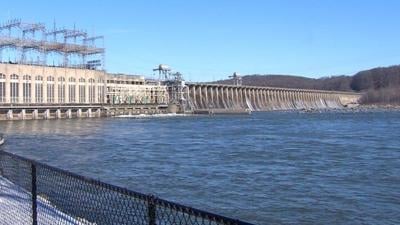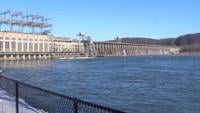CONOWINGO, Md. - Maryland Governor Wes Moore has announced an agreement between the state and Constellation Energy, operators of the Conowingo Dam, to implement operational and environmental improvements at the dam to promote the health of the Chesapeake Bay.
The Conowingo Dam’s hydroelectric facility operates on the Susquehanna River and is the largest source of renewable energy in Maryland, according to Moore’s office. The Chesapeake Bay Foundation says the Susquehanna, which runs through Pennsylvania into Maryland, is the source of about half of the Chesapeake Bay’s fresh water.
Pollution and sediment contained in that fresh water from Pennsylvania has been a major contributor to dead zones in the Chesapeake, according to state officials and environmental groups.
Constellation Energy and the Maryland Department of Environment entered an initial agreement in 2019 totaling about $200 million following widespread concern over water quality impacts associated with the Conowingo Dam’s operation. That agreement, according to the Chesapeake Bay Foundation, was insufficient and allowed Constellation to avoid water quality improvements normally required by Maryland. In 2021, environmental groups including the Chesapeake Bay Foundation challenged the agreement as well as a 50-year-permit for the Conowingo Dam to operate, arguing Constellation Energy was failing to mitigate pollution in the Susquehanna entering the Chesapeake. A U.S. Court of Appeals judge agreed in 2022, requiring a new agreement be reached.
The revised agreement, announced on Oct. 2, 2025, includes $87.6 million for pollution reduction and resiliency initiatives, $77.8 million in trash and debris removal, over $28 million for aquatic life passage and protection at the dam, $23.3 million in freshwater mussel restoration, and $18.7 million in dredging support. The whole agreement, and Constellation Energy’s renewed commitments, total over $340 million.
Constellation has also committed to help battle the ever-growing threat of invasive species like snakeheads, or Chesapeake Channa, and blue catfish in Chesapeake waters as part of the agreement.
“The Chesapeake Bay is the keystone to Maryland’s prosperity,” Governor Moore said Thursday. “This agreement will lead to real improvements in water quality in the biggest tributary of the Chesapeake Bay, while securing the future of one of our state’s largest clean energy producers. By bringing everyone to the table, we have struck an agreement that is good for the environment, good for energy production, and good for Marylanders.”
MDE issued a Revised Water Quality Certification to Constellation Energy on Thursday which is now expected to be incorporated into Constellation’s license to operate the dam, according to the group Waterkeepers Chesapeake. Once incorporated, Moore’s office says the obligations will be fully and effectively enforced by Maryland.
“With this agreement, we are protecting clean water and vibrant ecosystems for generations to come while supporting jobs, commerce, and energy security,” said Maryland Department of the Environment Secretary Serena McIlwain. “All parties—including environmental groups who challenged a previous framework—have signed on. From restored fisheries to enhanced recreation and tourism, the benefits of a healthier Susquehanna River flow through our communities, our industries, and the Chesapeake Bay.”
Governor Moore’s office says cleaner waterways in the Chesapeake Bay Watershed bolster tourism and Maryland’s seafood industry, which together generate nearly $4 billion a year in economic activity.
“I am looking forward to this $340 million agreement which will invest in environmental projects over the next 50 years to support the health of the Susquehanna River and the beating heart of our state – the Chesapeake Bay,” said U.S. Senator Angela Alsobrooks. “This settlement will continue to provide reliable, clean energy for Maryland, clean up our environment by removing trash and debris, control invasive species, protect our ecosystem, and improve our state's water quality.”


